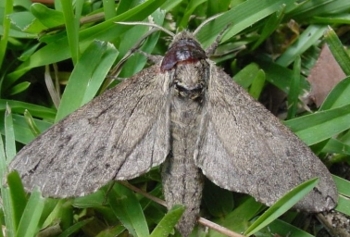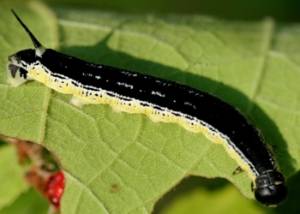Catalpa Sphinx Moth

These hornworms are native to the Eastern United States and can be found anywhere catalpa trees grow. Typically, catalpa worms are only a minor pest of catalpa trees; however, in some years, an outbreak can defoliate trees in a relatively short period. Because these caterpillars are native to the US, a host of beneficial insects serve as natural predators of these hornworms, so control is usually unnecessary.
Catalpa worms are a member of the hornworm family; however, unlike most hornworms, these caterpillars are rarely found individually and usually are found in groups. Young larvae are white with black spots and a black “horn.” However, as they get older, their colors can range from yellow to almost entirely black, but most of them are yellow with patches of black along their back and a dark black “horn.” Adults are heavy-bodied with enormous grey to brown wings with irregular dark markings and a wingspan of approximately 3 inches. The pupa overwinters at the base of the tree, and the adults hatch in the spring before laying eggs. This species is a boom-or-bust insect. Some years, they are almost impossible to find, and other years, they are numerous. If there are outbreaks, they usually occur for a couple of years before they disappear again. Control is rarely needed due to the countless natural predators; however, they make excellent fishing bait if you find them and are sometimes raised for that purpose.
brown wings with irregular dark markings and a wingspan of approximately 3 inches. The pupa overwinters at the base of the tree, and the adults hatch in the spring before laying eggs. This species is a boom-or-bust insect. Some years, they are almost impossible to find, and other years, they are numerous. If there are outbreaks, they usually occur for a couple of years before they disappear again. Control is rarely needed due to the countless natural predators; however, they make excellent fishing bait if you find them and are sometimes raised for that purpose.

Have questions? Contact our office where our Horticulture Extension Agent will assist you with questions.
Phone: (316) 321-9660
Email: callae@ksu.edu